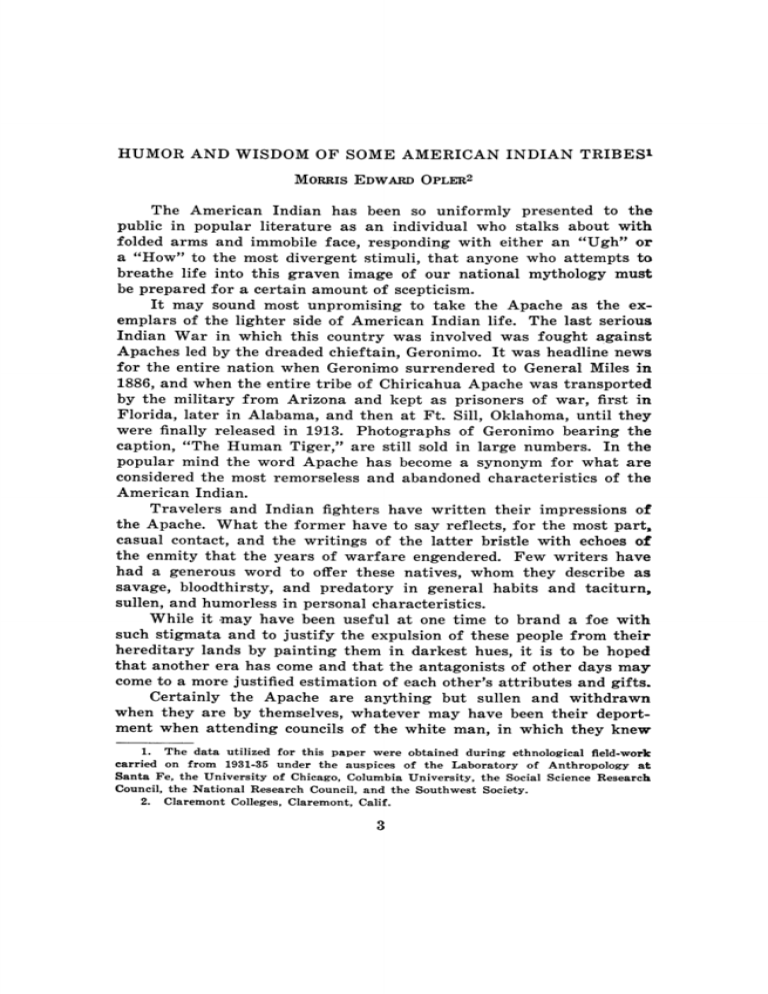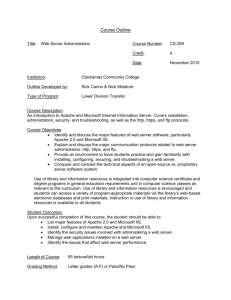Humor & Wisdom of Some American Opler 3
advertisement

HUMOR AND WISDOM OF SOME AMERICAN INDIAN TRIBES1 EDWARD OPLER2 MORRIS The American Indian has been so uniformly presented to the public in popular literature as an individual who stalks about with folded arms and immobile face, responding with either an "Ugh" or a "How" to the most divergent stimuli, that anyone who attempts to breathe life into this graven image of our national mythology must be prepared for a certain amount of scepticism. It may sound most unpromising to take the Apache as the exemplars of the lighter side of American Indian life. The last serious Indian War in which this country was involved was fought against Apaches led by the dreaded chieftain, Geronimo. It was headline news for the entire nation when Geronimo surrendered to General Miles in 1886, and when the entire tribe of Chiricahua Apache was transported by the military from Arizona and kept as prisoners of war, first in Florida, later in Alabama, and then at Ft. Sill, Oklahoma, until they were finally released in 1913. Photographs of Geronimo bearing the caption, "The Human Tiger," are still sold in large numbers. In the popular mind the word Apache has become a synonym for what are considered the most remorseless and abandoned characteristics of the American Indian. Travelers and Indian fighters have written their impressions of the Apache. What the former have to say reflects, for the most part, casual contact, and the writings of the latter bristle with echoes of the enmity that the years of warfare engendered. Few writers have had a generous word to offer these natives, whom they describe as savage, bloodthirsty, and predatory in general habits and taciturn, sullen, and humorless in personal characteristics. While it may have been useful at one time to brand a foe with such stigmata and to justify the expulsion of these people from their hereditary lands by painting them in darkest hues, it is to be hoped that another era has come and that the antagonists of other days may come to a more justified estimation of each other's attributes and gifts. Certainly the Apache are anything but sullen and withdrawn when they are by themselves, whatever may have been their deportment when attending councils of the white man, in which they knew 1. The data utilized for this paper were obtained during ethnological field-work carried on from 1931-35 under the auspices of the Laboratory of Anthropology at Santa Fe, the University of Chicago, Columbia University, the Social Science Research Council, the National Research Council, and the Southwest Society. 2. Claremont Colleges, Claremont, Calif. 3 4 NEW MEXICO ANTHROPOLOGIST they were foredoomed to come out second best. In their relations with each other they are spontaneous and fun-loving. They enjoy humorous stories and seek the company of those who can tell them best; practical joking has reached menacing proportions among them; they even practice that scourge of mankind, the pun. An example will illustrate the Apache use of the pun. The Apache word for chieftain or leader sounds remarkably like one which means "to shake the head." A braggart was regaling an unenthusiastic audience with an account of his chief-like qualities. Finally one listener, deliberately pretending to have misunderstood, broke in dryly, "Yes, but we all know that you can shake your head violently." One broad avenue of approach to Apache humor and satire is a story cycle concerning the adventures of an animal trickster, Coyote. Many of the stories have didactic value, for Coyote becomes involved in one scrape after another because of acts of avarice, theft, and immorality which all worthy men should shun. But other tales seem included solely for their mirth-provoking qualities. One such describes the quarrel between Coyote and Wildcat over which one could reach farther down his back to scratch himself. The antics of Coyote, as he tries to equal the supple skill of Wildcat in this matter, are developed in vivid detail for an appreciative audience, and it must be remembered that the Apache story-teller is as much the actor as the raconteur. In another coyote episode the greed of the Caucasian conquerors is slyly lampooned. Coyote ties all his wealth, a few pieces of silver, to the boughs of a tree. When white prospectors are passing by, he tells them of his "money tree" and convinces them by shaking down the pieces he has placed there that it bears nothing but coins. Coyote exchanges the tree for the equipment of the white men and leaves them to languish there vainly waiting for the harvest of silver. In connection with story-telling, the Apache use a device reminiscent of the tactics of our more incorrigible practical jokers. When myths and tales are being told for the benefit of the youngsters and some child is busily engaged in creating a disturbance rather than in giving undivided attention to what is being said, the old man will pause, search unsuccessfully for something, and then say in an ingratiating voice to the miscreant, "My child, won't you go over to the next camp and ask for 'that with which one smokes?' " Everyone to whom this request has been made in the past suppresses his mirth. The article mentioned is a fabulous one and corresponds exactly to our left-handed monkey wrench. When the child arrives at the next camp and asks for "that with which one smokes" he is gravely told that it has been borrowed only a moment before by someone who lives in the camp beyond. So the child is sent on his journey and continues his vain effort to catch up with the mysterious object. At length he NEW MEXICO ANTHROPOLOGIST 5 grows suspicious, or someone, thinking he has been punished enough, explains to him the endless nature of his quest. The Apache story-teller, especially when quite a group has gathered for the occasion, enlivens his recital by asides and insinuations which keep interest at a high pitch. Out of the corner of his eye he watches a prospective victim whose attention is straying. When he gets to a point in the story where Coyote has done something extraordinarily shameful or foolish, he makes a quick outward gesture with forefinger and thumb in the direction of his unsuspecting butt and says, "I guess that one did it." The one addressed looks up immediately, but the story-teller has already resumed the thread of his disclosure and is glancing calmly about with an air of greatest innocence. The victim joins in the general laugh, not knowing whether it is directed at him. Then the contest between the two begins. The first tries to catch the other off guard; the second tries to catch his tormentor in the act. Should the gesture be intercepted by the one for whom it is meant, the old man looks for another dreamer to gather to his net. This trick of taking into confidence everyone except the individual against whom the joke is directed, plays a prominent part in Apache humor. And so, when an Apache makes some request he knows cannot possibly be granted or gives some persuasive misinformation, if the person he is addressing should glance aside for a moment, he sticks out his tongue for the benefit of the others. Likewise the Apache gets a good deal of entertainment out of giving his fellows a good "dressing down." To indicate that what is said is uttered only in mock seriousness the arms are held akimbo. The ready quip, the seriously told extravaganza, the instant repartee were esteemed enough in Apache life so that one who excelled in them was a popular figure. A most respected Chiricahua Apache of a generation ago seemingly owed his prominence among his people to his reputation as the outstanding wit and story-teller of his day. The Apache ideal was a fearless fighter and a successful hunter. All accounts agree that this man, Ickaje, was worthless in warfare. But he had a jester's license. When the warriors were, according to Chiricahua custom, practicing in sham battle, learning to dodge arrows and clubs, he would advise them, "When you're in a fight, don't dodEe. You might run into an arrow. Why do you men dodge around like that?" He excelled no more in the hunt than he did in warfare. But what he lacked in this kind of ability, he compensated for by imaginative means. One of his most solemnly told stories pictured his terrific exertions on one occasion when he was on horseback pursuing a deer. The horse was going full tilt towards the limb of a mesquite tree, according to the account, and Ickaje was in a fair way to be 6 NEW MEXICO ANTHROPOLOGIST impaled on the thorny growth. At the last moment he threw himself one way, the horse went the other, they both met on the other side of the limb, Ickaje landing gracefully in the saddle, and on they went to make the inevitable kill. Ickaje had a wife who was party to his crimes; "She was just as bad as he was," the Indians say. The more extravagant his story, the more imploringly he would turn to her and ask, "Isn't that true?" and she was always ready with the reassuring, "Yes, that's true." If anyone showed restlessness while listening to stories and acted as though he were going, Ickaje would quickly tell him, "Wait, we're going to cook something pretty soon," and to his wife, "Have you anything to eat?" Though there was no food in the place his wife would respond evenly, "Certainly, in just a few minutes I'll get it ready." The few minutes would stretch into hours, and the guest would realize that he was not being treated to hospitality but to some of Ickaje's conscienceless bantering. To his fellow Apaches who married more than one wife when they could so afford and who sometimes cut a woman's nostrils as a punishment for adultery, Ickaje, who had always lived an exemplary life with his one wife, would declare, "When a woman gets angry with me, I go off. I don't cut her nose. I don't beat my wife. I don't say anything. There is always another woman ahead, I say." Ickaje was left-handed, and his ready advice and colorful narratives were accompanied by sweeping gestures; these are still imitated by the living Chiricahuas of his generation who remember his art. Ickaje himself was one of the first to be killed when hostilities with the white men broke out. It is in his social dance songs that the Apache reveals a high order of social satire and a shrewd understanding of human foibles. These songs were sung to accompany dances that were held during the larger gatherings of Apache. Such gatherings could not take place very often when these people were widely scattered for the food quest in aboriginal times. Therefore these occasions were eagerly awaited, especially by the young men and girls, for they were the means of bringing young people together, provided the framework for assignation and romance, and proved more than once the means to mutual understanding and marriage. The social dance songs grow out of the human relationships involved. Anyone who has the talent and the wit may compose a new one and offer it for public approbation. If it meets with approval, it will be added to the repertory and will doubtless be sung on future occasions. Sometimes new words are improvised for established tunes, and, if they seem more apt, they displace the old lines. Sometimes both words and music are invented for a dance. I have recorded several such, composed within the last few years. As older people NEW MEXICO ANTHROPOLOGIST 7 die, some songs of which they were particularly fond and which they kept alive by repetition pass away with them, and other, newer favorites take their place for the living. In other words, these social dance songs are a vital, fluid means of social communication and reflect the spirit, humor, and wisdom of the time and the people. The words of the Apache song are few and pithy; their force lies in their implications. The first song I shall quote jibes at two men who seem afraid to join the dance and become involved with the maidens. Two men are afraid: I, I am among them. It is dangerous, It is dangerous. A reminder of the consequences of the last dance seems in order, and so the singer aims his verbal dart as follows: You, you flirt! Remembering her, you walk along The trail to Rio Bonito, Remembering her, you walk along. Nor is the state of the smitten youth forgotten: Woman from a far place, I liked you and became acquainted with you. Woman from a distant place, Because I like you I follow you about. There is another song in which the only words, many time repeated, are, "What belongs to us?" Let us allow an Apache to explain the significance of this cryptic question. One interpreted it to me in these words, "What belongs to us? Where are our possessions? We haven't got anything. That's what this song means. Many people get married but haven't anything. What is going to be ours when we get married? Suppose I am dancing. I want to marry a girl though I have nothing. Then I'll be ashamed when they sing this. Lots of boys are." The words of the next song are a delicate reminder of the ageold domestic triangle: "He asks me what has happened to his wife." Another mirrors the predicament of two young people who should be parting but cannot bring themselves to separate: Woman from a far land, Give me your moccasins that I may be going. Man from a far land, Give me your moccasins that I may be going. Still another embodies a sensible warning to a careless young woman who has been encouraging the wrong man: 8 NEW MEXICO ANTHROPOLOGIST Young woman, be very careful, For yonder young man is worthless. The singer has his word of ridicule for the young man who has become infatuated with an experienced woman much his senior, the mother of children: When there is a gathering for the ceremony, Sweetheart, I will take care of your baby for you, I will take care of your baby for you. The woman who takes too much for granted is not unknown to the Apache composer. He celebrates her in these words: Oh Mescalero maiden, you're jealous of me! When did we become so intimate That you should be jealous of me? The older women who try to conceal their years and still play the coquette are treated none too gently. One song berates them for their vanity: Old woman from Magine, Why do you comb your gray hair? Why do you part it? Why do you comb your gray hair? Another song pokes fun at them thus, assuming that they have fallen from the exertions of the dance: Woman, you who have no teeth, Why do you like to dance? Woman, where are your teeth? Get up, woman, don't become angry. In the favorite social dance song composed and sung by Naiche, Geronimo's ally in the Indian Wars, the gossips earn a sharp thrust: Oh Mescalero maiden, don't be afraid; They are already gossiping about us, But don't be afraid. They who speak so chew rocks; (i. e., are envious) Don't be afraid. The hesitant youth is the object of a sharp reminder too: Man from a distant land, Why do you talk to me? Why do you talk to me? Why do you talk to me? What have you done for me But just talk to me? Dawn comes and the morning light falls upon a hapless youth who has danced with the girl of his choice all night without being NEW MEXICO ANTHROPOLOGIST 9 able to convince her to take a daring step. He gently upbraids her in these phrases: My sweetheart, we surely could have gone home, But you were afraid. When it was night, we surely could have gone home, But you were afraid. Others have been more fortunate, and for those who have found their life companions in this concourse of people the singer has this refrain: They are about to come together, They dance back and forth together; Tomorrow, at dawn, let them go home together. Humor and wisdom are seldom strangers. But since this essay is no more than the merest introduction to a fresh evaluation of a folk, one example, drawn from the stories of the Jicarilla Apache, of what I consider to be evidence of profound wisdom and psychological penetration, must suffice. A certain Jicarilla woman repeatedly advised her husband of the great repugnance which a man who lived a short distance away aroused in her. The man in question was unusually stalwart and well liked, and was, moreover, on friendly terms with the woman's husband. He seemed to be offering the woman no offense, and the husband pondered over the fact of his wife's strange aversion. Finally he decided that his wife protested too much, and determined to test her. He told his wife he was going on a hunting trip which would keep him away for several days. He traveled in one direction until out of sight of his home, then circled and came to the dwelling of the man against whom his wife expressed so much animus. The husband requested from this man the loan of a suit of his clothes. This was a buckskin garment from which hung many pendents, and these made a characteristic noise which was well known in the camps. The owner of the clothes was surprised at the peculiar request, but nevertheless complied. The husband donned these clothes, and then, shortly after dusk, made his way to his own camp. His wife, recognizing the sound of the moving pendants, thought the owner of the clothes was coming to her. The thin rationalization of protest with which she had veiled her intense desire for the man melted swiftly away, and she eagerly awaited his coming. The masquerading husband approached, but remained in the shadows so that his identity would not be revealed. The woman spilled the water from her water jar to provide an excuse for going out in the dark to the stream. The man followed, and when she lay down near the bank on her blanket, he picked her up in the 10 NEW MEXICO ANTHROPOLOGIST blanket and threw her bodily into the water. Then he went back to his friend and disposed of the clothes. Not long afterward he came home, pretending to have changed his mind about the hunt, and he expressed great surprise at finding his wife soaking wet. The miserable woman blamed her children, saying that they had spilled the contents of the water jar and that, to replenish the supply, she had gone out in the dark and fallen into the water. The husband very wisely said nothing and was relieved to find that thereafter his wife had no more to say about the man whose presence had so disturbed her previously. Everyone knows that the American Indian wore trailing feather headdresses, took scalps, and lived in tipis, though these facts are only partially true. What we have to learn, and this happens to be entirely true, is that the first inhabitants of this country were warm and colorful personalities whose zest for life has preserved much that we can add to our national lore. CONFERENCE OF SOUTHWESTERN ANTHROPOLOGISTS CHACO CANYON At the close of the Chaco Field Session, some ninety anthropologists and students interested in Southwestern problems met in Chaco Canyon for the second annual informal conference. The first evening, August 27, the discussion centered around the suggestion that a central ceramic laboratory be established in the Southwest to name and describe or validate new pottery types. The idea was approved but no suggestions were made as to how it could be put into effect. A discussion of restoration and preservation of sites for the benefit of the public followed. On the morning of August 28, Dr. Brand conducted the conference meeting which included some remarks on Navajo archaeology by Dr. Mera and Malcolm Farmer. The remainder of the morning was devoted to listing individuals and institutions qualified to aid in identifying animal bones, shell material, human skeletal remains, and textiles. The revised list is included in this issue. The afternoon meeting, conducted by Dr. Haury, was devoted to brief accounts of recent work at various archaeological sites in the Southwest. Dr. H. S. Colton, of the Museum of Northern Arizona, described a group of sites on the northeast slopes of the San Francisco Peaks where there was a fusion of several cultures. Dale King and Malcolm Rogers worked sites along the Colorado River. Watson Smith, of Peabody Museum, carried on a survey of sites and mapped

![[#MODULES-2756] apache::mod::deflate exec mkdir error](http://s3.studylib.net/store/data/007740364_2-82c5aa7294b9b87bcd9af8c86f942c1c-300x300.png)




